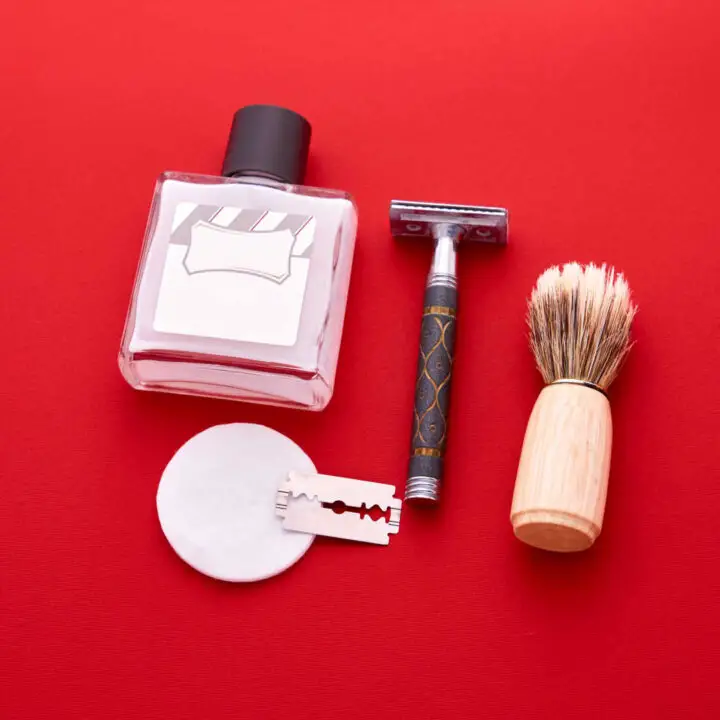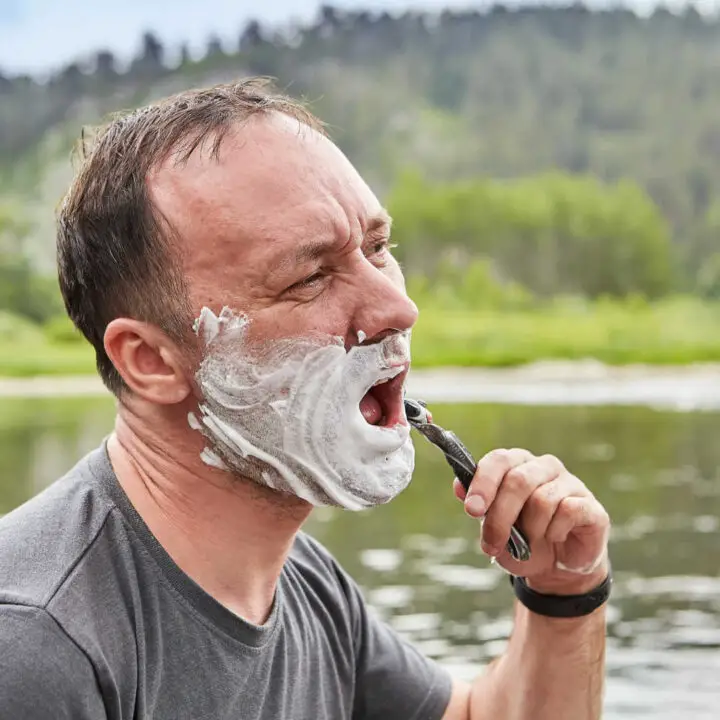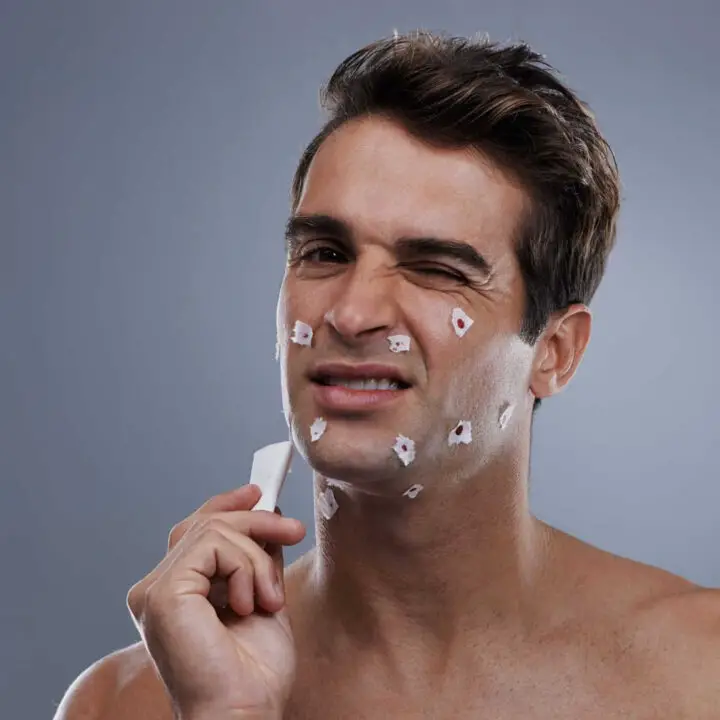
Shaving without a mirror can seem daunting, but there are plenty of reasons that might lead you to try it. Whether you’re traveling, camping in the “great outdoors,” or simply pressed for time, you may find yourself needing to shave without the benefit of seeing yourself.
Learning to shave without visual feedback poses its own set of challenges. You’ll have to rely on touch and feel, which can be difficult at first. However, there may be benefits: mastering this technique can enhance your shaving skills overall, making you more confident and efficient in your grooming routine.
This guide will walk you through everything from preparing your shaving area to selecting the right tools, mastering the touch-based approach, and perfecting your shaving technique—all without a mirror.
Preparing Your Shaving Area
The first step in a successful mirror-free shave is to set up the shaving area. The right environment can significantly enhance your experience and results. Here’s how to create a practical and comfortable space.
Setting Up a Touch-Friendly Environment
Begin by choosing a flat, stable surface to work on. A bathroom counter or a small table will do just fine. Keep the area clean and free of clutter, as distractions can lead to mistakes. Consider using a non-slip mat or towel to prevent your tools from sliding around. This not only keeps everything secure but also provides a tactile surface that feels good under your hands.
Next, arrange all your necessary tools within arm’s reach. You’ll want your razor, shaving cream or soap, brush, and any post-shave products handy. This organization minimizes movement and allows you to focus solely on the task at hand. Use small containers or trays to hold these items; this way, you won’t fumble around looking for what you need mid-shave.
Creating Ideal Lighting Conditions Even Without a Mirror
Good lighting is beneficial, even when you’re not using a mirror. Natural light is probably the best option if available, but if you’re in a low-light area, consider investing in bright, adjustable LED lights.
Essential Tools and Products

When it comes to mastering the art of shaving without a mirror, having the right tools and products at your disposal can make all the difference. Choosing the right razor is crucial. Here’s a quick comparison:
- Cartridge Razors: These are user-friendly and convenient, especially for beginners. While they offer ease of use, they may not deliver the same tactile feedback as safety razors, which can be important when shaving without visual guidance.
- Safety Razors: These are often preferred for their precision and safety features. They help you maintain control, making it easier to navigate your face by feel. Plus, they typically provide a closer shave with less irritation.
- Pivot-head Safety Razors: This may be a good compromise, as you may get the benefits of a safety razor with the angle of shaving less important.
Recommended Shaving Creams and Soaps
The right cream or soap can enhance the shaving experience. Look for products that provide good tactile feedback. Here are some key points:
- Creams: A rich, thick shaving cream helps you feel where you’ve already shaved. Look for those containing moisturizing ingredients like glycerin.
- Traditional soaps, especially artisanal options with natural ingredients, often create a more tactile-rich lather compared to mass-produced creams. Look for formulations that contain glycerin, lanolin, or coconut oil to keep the skin hydrated and receptive to your razor’s feedback.
Mastering the Touch-Based Approach
When it comes to shaving without a mirror, develop a mental map of your face: knowing the contours and features of your face will help you navigate as you shave. Start by gently running your fingers over your jawline, cheeks, and neck to familiarize yourself with these areas. Recognizing the different textures will aid in identifying where stubble remains.
Using your non-dominant hand as a guide can help. As you shave with your dominant hand, let your non-dominant hand feel for any uneven spots or stubborn stubble. This technique allows for better control and ensures you don’t miss any areas.
To track your progress effectively, focus on the sensation of the blade against your skin. Pay attention to how it glides smoothly over shaved areas while feeling slightly draggy on stubbly parts. By honing in on these tactile cues, you’ll quickly learn to differentiate between smooth and rough patches on your face.
Step-by-Step Shaving Technique

Pre-Shave Preparation to Maximize Success
Before diving into a mirrorless shave, it’s essential to set the stage. Start by washing your face with warm water to help soften the hair and make it easier to shave. Then, apply a generous amount of shaving cream or soap. Look for products that provide excellent tactile feedback, allowing you to feel where you’ve applied lather. A well-prepared face not only improves the shaving experience but also reduces the risk of nicks and irritation.
Directional Shaving Patterns That Work Without Visual Guidance
When shaving without a mirror, understanding the direction of hair growth is key. Begin by identifying the grain of your facial hair. For example, many people have hair that grows downward on their cheeks and upward on their neck.
- Start with the cheeks: Move your razor downwards in smooth strokes, letting your fingers guide the blade.
- Move to the jawline: Here, you might need to switch directions. Feel the stubble and adjust your angle accordingly; usually, upwards strokes work best.
- Tackle the neck: This area can be tricky due to its contours. Shave upwards, feeling for any uneven spots as you go.
Using your non-dominant hand as a guide not only helps maintain balance but also allows you to navigate challenging areas like the upper lip and chin more effectively.
Techniques for Difficult Areas (Neck, Jawline, Upper Lip)
The neck, jawline, and upper lip are often the most challenging areas to shave without a mirror. To handle these tricky spots:
- For the neck: Use a light touch and short strokes. If you’re unsure, alternate between up and down strokes to ensure you get a smooth shave without cutting yourself.
- For the jawline: Tilt your head slightly to feel the angles better. Use the edge of the blade to trace along the contours gently. Your fingers can help you keep track of where you’ve shaved.
- Upper lip: This area requires precision. Use your fingers to lift your lip slightly, making the hair more accessible. Shave in small, careful motions, paying close attention to the sensation of the blade against your skin.
Post-Shave Care Without Visual Confirmation
After you’ve navigated the unique challenges of shaving without a mirror, it’s time to focus on post-shave care. This phase is important for maintaining healthy skin and ensuring a smooth finish, even when you can’t see the results.
Start by running your fingers gently over your face. The skin will feel different in areas where stubble remains – it might feel rough or bumpy compared to the smoothness of shaved skin. Pay special attention to tricky spots like the neck, jawline, and upper lip.
Use a systematic approach: start at one side of your face and work your way across. This helps ensure that you don’t miss any patches while building confidence in your touch-based technique.
Once you’re satisfied with your shave, it’s time to apply aftershave. For this step, choose products with a recognizable texture. Gels and creams are great options because their consistency provides feedback as you apply them.
To apply, take a small amount in your hands and spread it across your palms before gently pressing it onto your face. This method allows you to cover all areas evenly, helping to soothe any irritation and hydrate the skin.
Addressing Nicks and Cuts You Can’t See

Even the most careful shaver may encounter nicks or cuts while shaving without visual confirmation. If you feel any tenderness or bumps, apply pressure with a clean finger to stop any bleeding.
Consider using a styptic pencil or an antiseptic ointment if you detect a cut by touch. This can help prevent infection and promote healing. Remember, regular practice will enhance your tactile awareness, making you better equipped to handle these situations over time.
With these post-shave strategies, you’ll be able to ensure that your skin remains healthy and irritation-free, setting the stage for future shaving sessions. This careful attention helps maintain your grooming routine even in the absence of a mirror, allowing you to master the art of mirrorless shaving.
Common Mistakes and How to Avoid Them
Shaving without a mirror can be tricky, and it’s easy to make mistakes that could jeopardize your results.
One of the most frequent mistakes is hurrying through your shave. When you’re pressed for time, it might feel tempting to speed things up, but this often leads to nicks and uneven areas. Take your time to feel every inch of your skin. A mindful approach not only ensures better results but also helps you build confidence in your touch-based technique. Slow down, breathe, and enjoy the process!
Another critical mistake is using the wrong blade angle or applying too much pressure. Without a visual guide, you might inadvertently press down harder than needed. This can cause irritation or cuts. Instead, focus on a light, gentle touch. Aim for about a 30-degree angle with the blade against your skin. This will help you glide over your face smoothly, minimizing the risk of injury.
It’s also common to miss spots when you can’t see what you’re doing. To combat this, develop a systematic way of checking your work. After shaving each section, run your hands over your face to feel for any stubble you’ve missed. You can use your fingers to trace the contours of your face—this tactile method will help you identify areas that need extra attention.
Special Situations and Adaptations
Learning to shave without a mirror opens up a world of adaptability. Whether you’re maintaining a beard, dealing with sensitive skin, or finding yourself in an emergency, there are strategies to ensure a smooth experience even when visual feedback is absent.
Shaving with a Beard
For those who sport a beard or specific facial hair styles, mastering the art of mirrorless shaving can help you maintain your look effortlessly. Start by developing a tactile awareness of your beard’s length and shape. Use your fingers to feel the contours and density of your facial hair.
- To trim, glide your razor along the outer edges of your beard, using your non-dominant hand as a guide.
- For precision, focus on smaller areas at a time, ensuring that you’re following the natural shape of your facial hair.
This method not only preserves your style but also hones your touch-based skills.
Emergency Shaving Scenarios
Life can throw curveballs, leading to unexpected moments where you need to shave without a mirror—think power outages or broken mirrors. In such cases, preparation is key:
- Ensure that all your shaving tools are organized and easily accessible. Familiarize yourself with their locations so you can navigate them by touch.
- If you’re in a pinch, try using your smartphone’s flashlight feature for extra lighting. Position it near your shaving area to illuminate your face without needing a mirror.
These strategies can help you tackle any shaving predicament confidently.
Summing Up
Develop a mental map of your face. This understanding helps you navigate contours and feel stubble as you shave. Utilizing your non-dominant hand as a guide is another crucial approach; it allows for greater control while maintaining a steady touch, ensuring a more consistent shave.
Beyond the immediate benefits of mirrorless shaving, this skill cultivates mindfulness and tactile awareness. You’ll learn to trust your senses and improve your dexterity, which can enhance other daily tasks too.
To continue building confidence, practice. Consider setting aside time for progressive training exercises, starting with partial mirror-free sessions before fully committing. Celebrate small victories along the way, as every step you take reinforces your ability.
With these techniques and encouragement, you’re well on your way to becoming a pro at mirrorless shaving. Embrace the journey ahead, knowing that each shave brings you closer to mastering this unique skill.

Shaving without a mirror? With a beard? WTF? As a guy with a beard, I can barely imagine a situation where I’d need to wet shave. I might use an electric beard trimmer, without the guard, to spruce up my neck for a wedding or something. But how about simply not shaving? Some don’t seem to consider that.
Then again I’m the kind of guy who operates on the philosophy: Don’t do today what you can put off until tomorrow! If you don’t absolutely HAVE to shave today, why bother? 🤣🍸